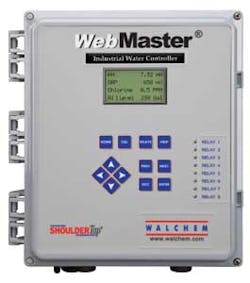Product Focus: Web-Enabled System Offers Improved Disinfection Control
The EPA requires drinking water to be clean and safe, and consumers have come to expect it. To ensure water is compliant, and the disinfection system is operating reliably, continuous on-line control, monitoring and reporting is essential.
SCADA systems used by large municipalities to monitor and control the chlorination process are cost prohibitive for most small communities. Standalone chlorine monitors are more affordable and help increase the reliability of the system, but they lack the ability to communicate problems. Fortunately, advancements in controller technology, along with changes in EPA regulations regarding direct-reading sensors, have resulted in a simple solution to maintain the proper chlorine residual.
Over the past few years, web-enabled controllers have been developed that have the ability to control the disinfection process, datalog, and remotely alarm when the system is out of the control range. These controllers, coupled with amperometric direct-reading sensors, provide a reliable, low cost system that's easy to maintain. Remote access improves visibility to the system, while reducing the man-hours required performing on-site inspections. These disinfection systems are very appropriate and cost-effective for small decentralized drinking water systems, employing many of the SCADA features, without the large capital investment.
One such web-enabled controller is Walchem's WIND WebMaster. The controller integrates sensing, control, datalogging, and remote communications in a single NEMA 4X enclosure. There are four direct sensor inputs for measurements such as pH and chlorine, as well as analog and digital inputs for flow meters, tank levels, chemical pump feed verification, leak detection, etc. The user simply selects from a menu of standard pre-programmed algorithms, such as pulse proportional control or PID, to regulate chemical feed addition in response to varying flow rates.
Graphing, trending and on-board diagnostics are included to remotely troubleshoot the system and reduce on-site visits. These controllers will communicate their status to maintenance technicians and supervisors via cell modem, phone line or Ethernet.
The amperometric sensors used with the controllers read free chlorine directly, even at wide ranges of pH, without the use of a secondary pH sensor. Amperometric sensors don't need reagents, and only require routine maintenance every 3 - 6 months. The sensors monitor the residual chlorine continuously as opposed to intermittent sampling provided by colorimetric chlorine analyzers.
Web-enabled controllers like the WIND gather data and provide a method for interaction with maintenance staff. The data and graphs can be viewed online, and that information can be used to increase the efficiency of the system. The deadband, pump speed and control algorithms can be adjusted remotely to reduce deviation from set points and improve overall system performance. In the event of an alarm, the controller can send e-mails and cell phone text messages for rapid response. Remote access allows the user to make immediate changes to set points or turn devices on and off, such as pumps and valves, provided they have the proper security authorization.
Security is an important aspect of Web-enabled controllers. The controller should be user name and password protected. Different levels of access to the controller should be available, such as a view only, technician level, and supervisor configuration level. These different levels of access control not only who has the ability to make a change, but also the type of change they are permitted to make.
Conclusion
Advancements in controller technology, combined with the EPA's approval of direct-reading chlorine sensors, provide smaller communities with drinking water disinfection systems that are within their budget, yet provide many of the benefits of a SCADA system. WW
